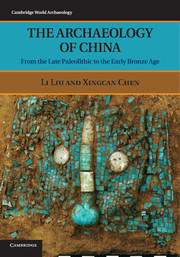Book contents
- Frontmatter
- Contents
- Illustrations
- Tables
- Preface
- Chapter 1 Chinese archaeology: Past, present, and future
- Chapter 2 Environment and ecology
- Chapter 3 Foragers and collectors in the Pleistocene-Holocene transition (24,000–9000 cal. BP)
- Chapter 4 Domestication of plants and animals
- Chapter 5 Neolithization: Sedentism and food production in the early Neolithic (7000–5000 BC)
- Chapter 6 Emergence of social inequality – The middle Neolithic (5000–3000 BC)
- Chapter 7 Rise and fall of early complex societies: The late neolithic (3000–2000 BC)
- Chapter 8 Formation of early states in the Central Plain: Erlitou and Erligang (1900/1800–1250 BC)
- Chapter 9 Bronze cultures of the northern frontiers and beyond during the early second millennium BC
- Chapter 10 The late shang dynasty and its neighbors (1250–1046 BC)
- Chapter 11 Chinese civilization in comparative perspective
- Appendix Horse bones in faunal assemblages from Neolithic and early Bronze Age sites in north China
- Glossary
- References
- Index
Chapter 1 - Chinese archaeology: Past, present, and future
Published online by Cambridge University Press: 05 June 2012
- Frontmatter
- Contents
- Illustrations
- Tables
- Preface
- Chapter 1 Chinese archaeology: Past, present, and future
- Chapter 2 Environment and ecology
- Chapter 3 Foragers and collectors in the Pleistocene-Holocene transition (24,000–9000 cal. BP)
- Chapter 4 Domestication of plants and animals
- Chapter 5 Neolithization: Sedentism and food production in the early Neolithic (7000–5000 BC)
- Chapter 6 Emergence of social inequality – The middle Neolithic (5000–3000 BC)
- Chapter 7 Rise and fall of early complex societies: The late neolithic (3000–2000 BC)
- Chapter 8 Formation of early states in the Central Plain: Erlitou and Erligang (1900/1800–1250 BC)
- Chapter 9 Bronze cultures of the northern frontiers and beyond during the early second millennium BC
- Chapter 10 The late shang dynasty and its neighbors (1250–1046 BC)
- Chapter 11 Chinese civilization in comparative perspective
- Appendix Horse bones in faunal assemblages from Neolithic and early Bronze Age sites in north China
- Glossary
- References
- Index
Summary
The archaeological materials recovered from the Anyang excavations…in the period between 1928 and 1937…have laid a new foundation for the study of ancient China.
(Li, C. 1977: ix)When inscribed oracle bones and enormous material remains were found through scientific excavation in Anyang in 1928, the historicity of the Shang dynasty was confirmed beyond dispute for the first time (Li, C. 1977: ix–xi). This excavation thus marked the beginning of a modern Chinese archaeology endowed with great potential to reveal much of China's ancient history. Half a century later, Chinese archaeology had made many unprecedented discoveries that surprised the world, leading Glyn Daniel to believe that “a new awareness of the importance of China will be a key development in archaeology in the decades ahead” (Daniel 1981: 211). This enthusiasm was soon shared by the Chinese archaeologists when Su Bingqi announced that “the Golden Age of Chinese archaeology is arriving” (Su, B. 1994: 139–40). In recent decades, archaeology has continuously prospered, becoming one of the most rapidly developing fields of social science in China.
- Type
- Chapter
- Information
- The Archaeology of ChinaFrom the Late Paleolithic to the Early Bronze Age, pp. 1 - 21Publisher: Cambridge University PressPrint publication year: 2012
- 1
- Cited by



